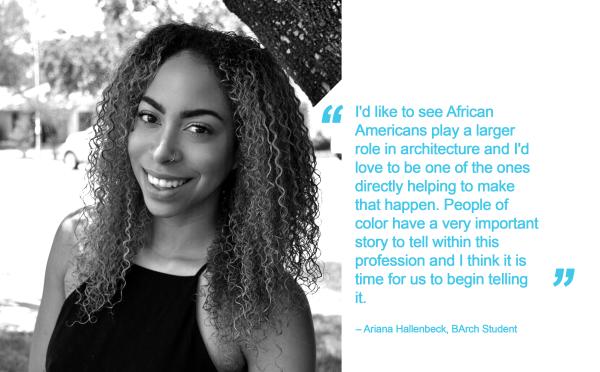Ariana Hallenbeck, Student

In this post, we hear from Ariana Hallenbeck. Having returned recently from a 6-month Professional Residency Program internship at Perkins & Will in Dallas, Ariana is completing her final semester at the School of Architecture and looking forward to graduation.
In the School of Architecture, what degree are you seeking? What year are you in?
I am in the last semester of my fifth year in the Bachelor of Architecture degree program.
In what ways have you incorporated diversity and equity issues as part of your educational experience?
For me, diversity and equity are vastly important, so I've tried to incorporate issues related to this in my education in several ways. For the most part, I've concentrated my elective courses in the School of African and African Diaspora Studies. These courses have given me a foundation on how to really analyze and discuss issues of diversity, which I have then tried to bring back into my education in the School of Architecture.
I have joined several organizations committed to the empowerment of minorities on campus, including NOMAS, the student organization of NOMA [National Organization of Minority Architects], an institution started with the help of the first African American admitted into the UT School of Architecture, John S. Chase, and one of the first to be admitted to The University of Texas at Austin period. I think it is of the utmost importance to uphold this legacy, and why I champion the greater representation of minorities in the school.
Additionally, in my courses specifically, I have focused research papers on explorations of Black architects and Black architecture, and I have used the knowledge gained to incorporate into some of my studio projects, one of these projects being a community center in South Los Angeles. I chose this studio in particular because it had been the first time I was presented with an option to design a project within a community that was not predominantly white and of higher socioeconomic status. With this project, I was able to infuse an aesthetic based on the culture of the community and incorporate a screen facade inspired by traditional African art and wood sculptures.
Outside of UTSOA, I am a member of the Fearless Leadership Institute, an organization dedicated to the personal and professional development of women of color, and I have also previously worked for the Office of Institutional Equity on campus, which developed my understanding of diversity and equality in the legal sense.
What does diversity mean to you?
A simple way of defining diversity would be to discuss it as the range of inputs and outputs within a system. In school, diversity can be measured in the context of both people and content: who is being taught, who is teaching, what is being taught, and what are students producing. These are questions that can begin that discussion. Viewing diversity in broader terms and through a variety of lenses can be very beneficial, but I think it is essential for us to recognize the importance of diversity in relation to race, gender, and socioeconomic status, and to use this as a central way of measuring diversity, otherwise, we may miss out on addressing inequalities experienced by historically disadvantaged groups.
Can you describe the sense of community at the School?
What I think is really interesting is the ways in which a sense of community is established in different cultural groups. On campus, too, communities are formed based on similarities in identities, often the first of these being major identification. Because UTSOA is such a small school, a sense of community is almost hard not to have. We typically know, although at varying levels, each and every person in our year, and oftentimes many members outside of our year and outside of our own degree plans. Within the school, we bond not simply based upon our demographic backgrounds, although this is still present, but more on our shared experiences of surviving architecture school. The people you may have had studio with most or whom you have pulled the most all-nighters with, are often the ones you become closest with, perhaps even then living with them. Rather than being just classmates, many of our main friends on campus become centralized within the School of Architecture.
What are your aspirations –big or small– for the future?
I feel like I have many aspirations for the future, both related and unrelated to the field of architecture. I think ultimately these are strung together by a common purpose of continuing to carve out pathways for more minorities to penetrate this field. I'd like to see African Americans play a larger role in architecture and I'd love to be one of the ones directly helping to make that happen. I attended a high school that has an architecture program, and I'd like to potentially create a program that connects students in some of these more economically disadvantaged areas to architecture schools and architecture firms and increase the opportunities for success for these students. Ultimately, I'd like to focus on architecture relating to communities of color and aid in making sure the voices of these community members and members within the profession can be better represented and heard. I believe people of color have a very important story to tell within this profession and I think it is time for us to begin telling it.

